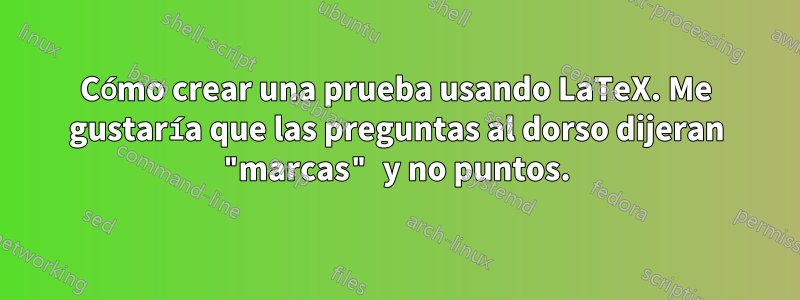
Estoy intentando usar látex y hacer una prueba. Me está costando mucho recrear esto.
Esto es lo que tengo hasta ahora: tengo los títulos y el cuadro, pero no estoy seguro de cómo agregar el nombre en el lado derecho junto con el cuadro de la derecha que tiene las marcas totales.
También quiero que las preguntas digan "notas" y no "puntos". Tampoco estoy seguro de hacer esto. Cualquier ayuda es muy apreciada.
Gracias
\documentclass{exam}
\usepackage{graphicx}
\usepackage[a4paper, total={7in, 10in}]{geometry}
\usepackage[framemethod=tikz]{mdframed}
\usepackage{lipsum}
\usetikzlibrary{shadows}
\newmdenv[tikzsetting={fill=white},
roundcorner=0pt,shadow=false,]{myshadowbox}
\usepackage[framemethod=tikz]{mdframed}
\usepackage{lipsum}
\usetikzlibrary{shadows}
\newmdenv[tikzsetting={},
roundcorner=0pt,shadow=false,]{highlight}
\begin{document}
{\huge Maths Methods, Units 1/2}
{\Huge Quadratic Functions Test}
\begin{highlight}
{\LARGE SECTION A: }
\noindent No notes allowed.\\
NO calculator.
\end{highlight}
\begin{questions}
\question[2] What is ?
\end{questions}
\newpage
\begin{highlight}
{\huge SECTION B: TECHNOLOGY ACTIVE}\\
\noindent Notes are allowed. A CAS calculator may be used.
\end{highlight}
\begin{highlight}
\noindent {\LARGE PART I: MULTIPLE CHOICE}\\
\end{highlight}
\newpage
\begin{highlight}
{\LARGE PART II: EXTENDED RESPONSE}\\
\end{highlight}
\end{document}
Respuesta1
Si desea incluir el nombre, puede utilizar este fragmento de código:
\documentclass{exam}
\usepackage{graphicx}
\usepackage[a4paper, total={7in, 10in}]{geometry}
\usepackage[framemethod=tikz]{mdframed}
\usepackage{lipsum}
\usetikzlibrary{shadows}
\newmdenv[tikzsetting={fill=white},
roundcorner=0pt,shadow=false,]{myshadowbox}
\usepackage[framemethod=tikz]{mdframed}
\usepackage{lipsum}
\usetikzlibrary{shadows}
\newmdenv[tikzsetting={},
roundcorner=0pt,shadow=false,]{highlight}
\begin{document}
\begin{flushright}
\begin{tabular}{@{}p{2cm}p{8cm}@{}}
NAME: & \hrulefill \\
\end{tabular}
\end{flushright}
{\huge Maths Methods, Units 1/2}
{\Huge Quadratic Functions Test}
\begin{highlight}
{\LARGE SECTION A: }
\noindent No notes allowed.\\
NO calculator.
\end{highlight}
\begin{questions}
\question[2] What is ?
\end{questions}
\newpage
\begin{highlight}
{\huge SECTION B: TECHNOLOGY ACTIVE}\\
\noindent Notes are allowed. A CAS calculator may be used.
\end{highlight}
\begin{highlight}
\noindent {\LARGE PART I: MULTIPLE CHOICE}\\
\end{highlight}
\newpage
\begin{highlight}
{\LARGE PART II: EXTENDED RESPONSE}\\
\end{highlight}
\end{document}
Respuesta2
Comencemos con el preámbulo:
\documentclass{exam}
\usepackage[dvipsnames]{xcolor}
\usepackage{tikz}
\usepackage{enumitem}
\usepackage{setspace}
\usepackage{anyfontsize}
\usepackage[framemethod=tikz]{mdframed}
\usepackage{lipsum}
\usetikzlibrary{shapes.geometric, calc, shadows}
Con estos paquetes podemos:
Defina comandos para el cuadro:
\newcommand{\notebox}[1]{
\begin{tikzpicture}
\draw[] (0,0) rectangle (3,2);
\node[above left] at (3,0){\fontsize{20}{35} \bfseries\sffamily /#1};
\end{tikzpicture}
}
\newcommand{\onelinenotebox}[1]{
\begin{tikzpicture}
\draw[] (0,0) rectangle (3,0.95);
\node[above left] at (3,0){\fontsize{20}{35} \bfseries\sffamily /#1};
\end{tikzpicture}
}
El primer método implica crear un rectángulo que se parezca mucho a un cuadrado, lo que se demostrará más adelante como ejemplo para la página principal. El segundo método utiliza un comentario para producir un pequeño cuadro debajo de la segunda sección.

Para que se pareciera más a la imagen de referencia, definí dos comandos adicionales para asegurar que los títulos tuvieran una longitud similar y el segundo se mostrara en negrita. Además, configuré las fuentes para que sean sans-serif con \textsf. Además, introduje un nuevo entorno llamado myitemizepara simplificar la organización del texto dentro de los entornos highlighty myshadowbox. Esto permite un enfoque más ágil y menos engorroso para organizar el contenido. El código para esto es:
\newcommand{\serif}[1]{
{\spaceskip=1.2em\fontsize{25}{30} \selectfont \textsf{#1}}
}
\newcommand{\boldserif}[1]{
{\spaceskip=0.3em\fontsize{25}{30} \selectfont \textsf{\textbf{#1}}}
}
\newlist{myitemize}{itemize}{1}
\setlist[myitemize]{label={}, leftmargin=*, before=\setstretch{0.5}}
Haz el encabezado principal:
\begin{document}
% \begin{flushright} - Put everything on the right
\begin{flushright}
{\textsc{Name}: \rule{7cm}{1pt}}
% \textsc{} - Prints all capital letters, but the one that is capitalized is larger
% \rule{#Line width}{#Thickness}
\end{flushright}
\begin{minipage}{0.695\textwidth}
\begin{flushleft}
\serif{Maths Methods, Units 1/2}
\boldserif{Quadratic Functions Test}
\end{flushleft}
\end{minipage}
\begin{minipage}{0.295\textwidth}
\begin{flushright}
\notebox{40}
\end{flushright}
\end{minipage}
\begin{highlight}
\begin{myitemize}
\item {\LARGE SECTION A: }
\item No notes allowed.
\item NO calculator.
\end{myitemize}
\end{highlight}
\begin{questions}
\question[2] What is ?
\end{questions}
\end{document}
Haz el segundo encabezado:
\begin{highlight}
\begin{myitemize}
\item {\huge SECTION B: TECHNOLOGY ACTIVE}
\item \noindent Notes are allowed. A CAS calculator may be used.
\end{myitemize}
\end{highlight}
\begin{flushleft}
\begin{minipage}{0.695\textwidth}
\begin{highlight}
\begin{myitemize}
\item {\LARGE PART I: MULTIPLE CHOICE}
\end{myitemize}
\end{highlight}
\end{minipage}
\begin{minipage}{0.296\textwidth}
\begin{flushright}
\onelinenotebox{40}
\end{flushright}
\end{minipage}
\end{flushleft}
Tengo algunos comentarios que hacer sobre el código:
- No estoy muy familiarizado con la
examclase, por lo que tenía algunas limitaciones a la hora de formatear ciertos elementos. Como solución alternativa, utilicé elminipageentorno junto conflushrightyflushleftpor conveniencia. Si estuviera usando clases comobookoarticle, usaría eltitlesecpaquete para formatear los elementos, pero como me pidieron que usaraexamla clase, no quería complicar las cosas. - Hice algunos cambios menores para que fuera más fácil de escribir, como la introducción de los comandos y
myitemizeel entorno de escritura. Sin embargo, sólo son complementarios y no imprescindibles para lo que necesitas, por lo que simplemente puedes eliminarlos. - Por último, hay varios tipos de fuentes y configuraciones disponibles más allá de lo que se presenta en el código. Recomiendo leer y estudiar los siguientes dos enlaces para aprender más sobre ellos:
- Tamaños de fuente, familias y estilos - Al dorso
- El catálogo de fuentes LaTeX






